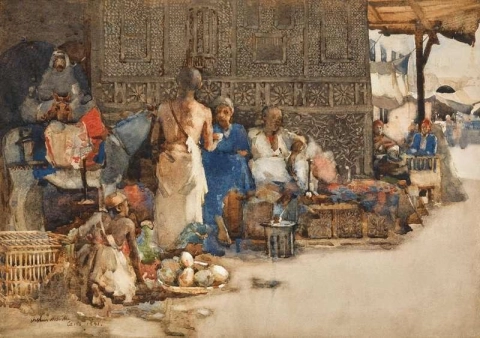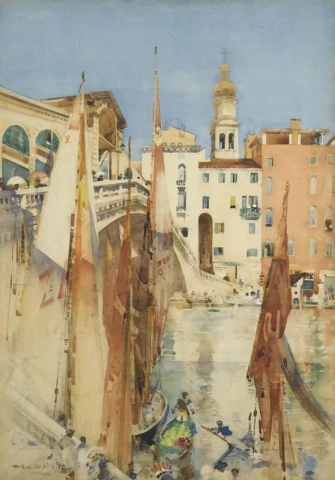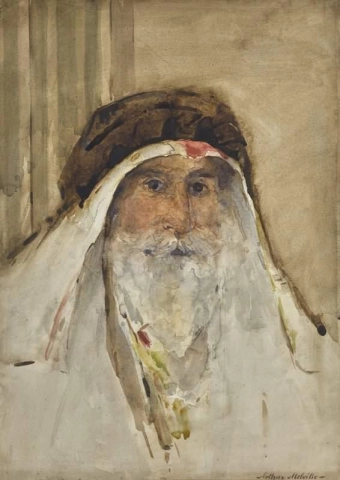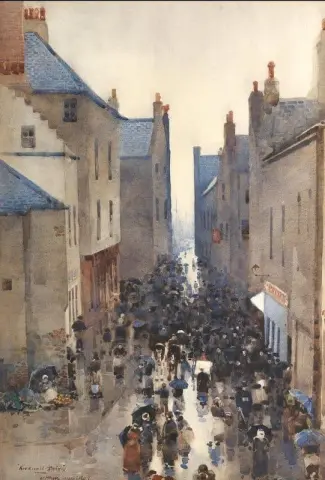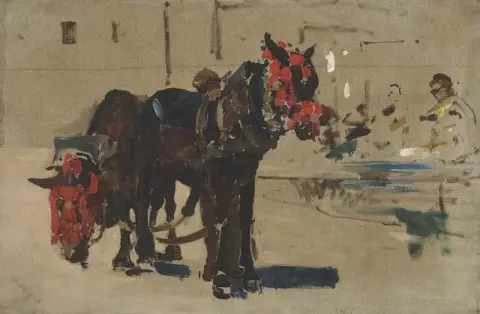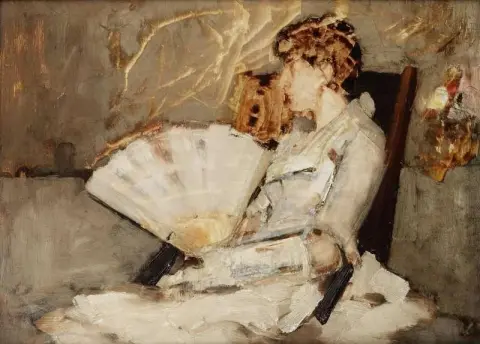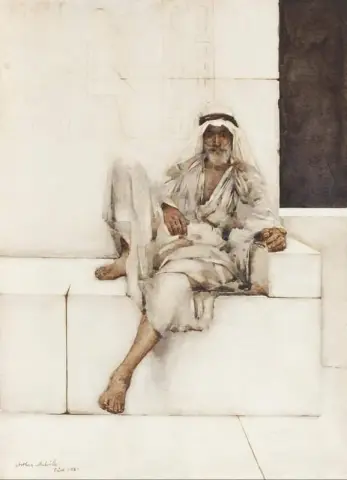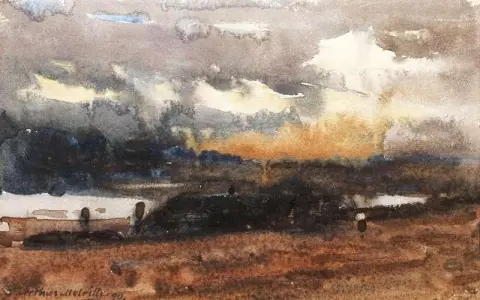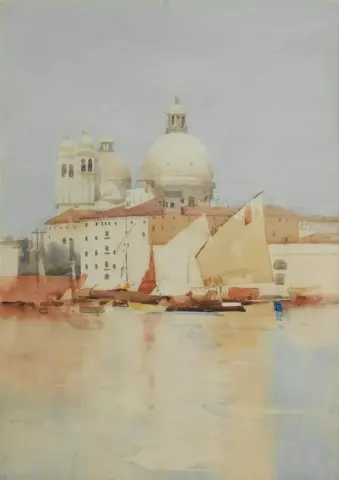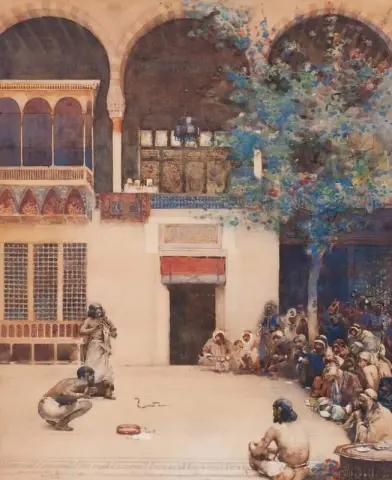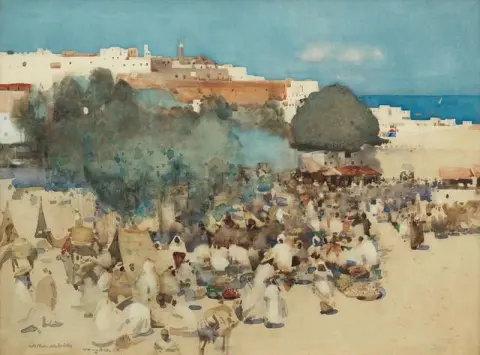

Hand painted reproductions of Arthur Melville
Arthur Melville: Scottish Painter
Arthur Melville (1855–1904) was a notable Scottish painter whose work spanned several artistic styles, including Orientalism, Impressionism, and Realism. He is known for his vibrant and atmospheric paintings, particularly those that depict scenes of the Middle East, as well as his powerful use of color and light. Melville's legacy is marked by his distinctive approach to landscapes, portraits, and genre scenes, characterized by their vivid color palettes and a nuanced understanding of light and shadow.
Early Life and Education
Arthur Melville was born in Edinburgh, Scotland, in 1855. He showed an early interest in art and entered the Royal Scottish Academy as a student, where he began his formal training. Melville’s artistic career was shaped by his time spent in Scotland, where he was influenced by the national art movements of the period, as well as by his travels across Europe.
Melville’s early works were more closely associated with the Realist movement, focusing on capturing the daily life and the atmosphere of the world around him. However, after he visited Spain and North Africa in the late 19th century, his style underwent a significant transformation. The vibrant colors and light of these regions had a lasting impact on his work, leading him to develop a more expressive and color-driven style.
Style and Technique
Arthur Melville’s painting style was heavily influenced by his exposure to Impressionism and the vibrant landscapes of the East. His work is characterized by bold color choices, a keen sense of light, and dynamic compositions. Melville was particularly adept at capturing the interplay between light and shadow, which gave his paintings a sense of depth and atmosphere.
While he initially painted in a more realistic manner, Melville’s style evolved as he experimented with color and technique. His paintings from his time in Spain and North Africa reveal a fascination with the exotic, which led him to adopt a style that drew heavily from Orientalism. In these works, he employed vivid color schemes and often painted scenes that conveyed a sense of mystery and grandeur.
One of Melville's key techniques was his use of bright, contrasting colors to convey mood and emotion. He often favored rich reds, oranges, and yellows in his landscapes, portraits, and genre scenes. This use of color made his works stand out for their vibrancy and depth. He also employed loose brushwork, allowing him to capture the fleeting moments of light and atmosphere that are characteristic of the Impressionist movement.
Themes and Significance
Melville’s body of work spans several different themes, with a particular emphasis on the exoticism of the Middle East and North Africa. His travels to Spain, Morocco, and Egypt had a profound influence on his art, and many of his later paintings focus on these regions, depicting their landscapes, architecture, and people.
One of Melville’s most distinctive features was his ability to blend Western artistic traditions with the allure of the East. His works often feature figures in traditional costumes or exotic settings, capturing the atmosphere of foreign lands with a romantic and dramatic flair. This fascination with the Orient was in line with a broader trend among European artists of the time, who sought to explore and depict the mysterious allure of the East.
Despite his focus on exotic locales, Melville also painted portraits and genre scenes that conveyed the quiet beauty of everyday life. His works often highlight the interplay between light and shadow, giving them a sense of realism and emotional depth. His early works, particularly his Scottish landscapes and genre scenes, reveal a meticulous attention to detail and a commitment to capturing the world as he saw it.
Achievements and Recognition
Arthur Melville enjoyed a successful career during his lifetime, exhibiting widely in both Scotland and England. His works were shown at major venues such as the Royal Scottish Academy and the Royal Academy of Arts in London, where he gained recognition for his innovative use of color and light. He was also a member of the prestigious Royal Scottish Society of Painters in Watercolour.
Melville’s travels to Spain and North Africa were pivotal in shaping his career, and they brought him widespread acclaim for his depictions of these exotic lands. His work was well received by critics and collectors, and he was regarded as one of the leading painters of his generation. However, despite his success, Melville’s career was cut short when he died at the age of 48, leaving behind a legacy of powerful and atmospheric paintings.
Legacy
Arthur Melville’s contributions to Scottish art and to the broader European painting scene are significant, especially in terms of his innovative use of color and his exploration of exotic themes. Although his career was brief, his work left a lasting impact, particularly in the realm of Orientalist art.
Today, Melville’s paintings are housed in collections around the world, including those of the Scottish National Gallery and the Royal Scottish Academy. His work continues to be admired for its vibrant color, emotional depth, and technical mastery.
Where to Find Reproductions of Arthur Melville's Art
Reproductions of Arthur Melville’s art can be found at POD, offering a variety of prints that capture his bold color choices and masterful handling of light. Whether you are drawn to his Orientalist works or his evocative depictions of everyday life, Melville’s paintings remain timeless in their beauty and emotional resonance.
Imagine owning an original-style painting by one of the greatest artists in history. At POD, we offer you the chance to make this dream a reality. Each canvas is faithfully reproduced down to the smallest detail, allowing you to experience the beauty of the artist’s vision in your own home.
Our reproductions are crafted by experienced painters using the finest materials and time-honored methods. We are committed to delivering works of exceptional quality that will inspire and bring joy to your family for generations to come.

